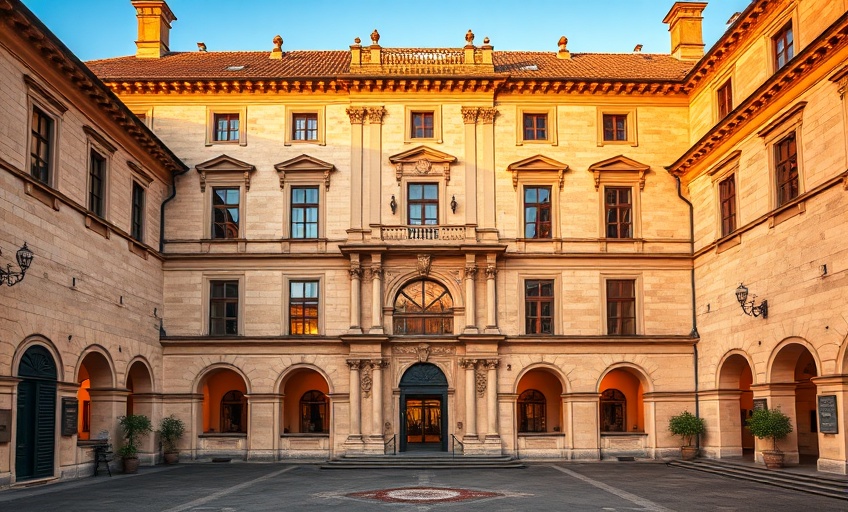Heritage & Environment
Discover Urbino's rich cultural heritage and environmental treasures. From Renaissance masterpieces to natural landscapes, explore the elements that make our city a UNESCO World Heritage Site.
Heritage Overview
Urbino preserves both tangible and intangible heritage that tells the story of Renaissance innovation and cultural continuity.
Tangible Heritage
Renaissance Architecture
Palazzo Ducale, churches, and palaces representing the pinnacle of Renaissance architectural achievement.
Urban Planning
Exceptional example of Renaissance urban design integrating natural topography with human settlement.
Historic Landscape
Harmonious relationship between built environment and surrounding Marche countryside.
Intangible Heritage
Educational Traditions
Continuous university tradition since 1506, maintaining Urbino's role as a center of learning.
Artistic Traditions
Living traditions of craftsmanship, ceramics, and artistic techniques passed down through generations.
Community Practices
Festivals, markets, and social customs that maintain the living character of the historic city.
UNESCO Recognition
Inscribed in 1998, Urbino exemplifies the ideals of the Renaissance city where art and culture seamlessly integrate with urban life.
Recognized for outstanding universal value as an exceptional example of Renaissance urban planning.
Meets criteria (ii) and (iv) for architectural and urban planning influence and outstanding ensemble.
Core zone encompasses the entire historic center with comprehensive legal protection framework.
Outstanding Universal Value
Urbino represents a pinnacle of Renaissance culture, where Duke Federico da Montefeltro created an ideal Renaissance court that attracted artists, humanists, and mathematicians from across Europe.
The city demonstrates exceptional integration of Renaissance architectural principles with natural topography, creating a harmonious urban landscape that has remained substantially intact.
Its influence on urban planning and architectural development extended far beyond Italy, contributing to Renaissance city planning concepts across Europe.
Key Attributes
- Renaissance urban layout and street pattern
- Palazzo Ducale architectural complex
- Integration with natural landscape
- Continuous living heritage character
Management Framework
Conservation Challenges
Balancing preservation of authentic Renaissance character with contemporary urban needs, managing tourism impacts, and maintaining traditional building techniques and materials.
Heritage Sites Explorer
Heritage Sites
Click on map markers or list items to explore

Palazzo Ducale
The magnificent ducal palace, a masterpiece of Renaissance architecture that houses the National Gallery of the Marche and showcases works by Piero della Francesca.
Cathedral of Urbino
Historic cathedral showcasing centuries of religious art and neoclassical architecture, rebuilt in the 19th century after an earthquake destroyed the original Renaissance structure.
Raphael's Birthplace
Visit the house where the great Renaissance master Raphael Sanzio was born in 1483. Now a museum dedicated to his life and early works.
Palazzo Albani
Elegant Renaissance palace featuring beautiful frescoes and architectural details, representing the refined taste of Urbino nobility.
Church of San Bernardino
Beautiful church with stunning architecture and historical significance, featuring remarkable artwork and peaceful atmosphere.
Botanical Garden of Urbino
University botanical garden featuring diverse plant species and peaceful walking paths, perfect for nature lovers and students.
Environment & Nature
The natural environment surrounding Urbino is integral to its World Heritage value, creating a harmonious landscape that has inspired artists for centuries.
Natural Setting
Apennine Foothills
Urbino sits majestically on twin hills within the gentle slopes of the Marche Apennines, creating dramatic vistas.
Agricultural Landscape
Traditional farming practices maintain the historic rural character with olive groves, vineyards, and grain fields.
Water Systems
Natural springs and streams have historically supplied the city and shaped the development of neighborhoods.
Olive Heritage
Ancient olive groves producing high-quality extra virgin olive oil using traditional methods.
Wine Terroir
Local vineyards producing distinctive Marche wines in harmony with the historic landscape.
Conservation Areas
Protected zones maintaining biodiversity and traditional ecological relationships.
Climate & Sustainability
Urbino's temperate climate and sustainable practices help preserve both cultural and natural heritage. The city implements green initiatives while respecting traditional landscape management.
Environmental Data
Heritage Resources
Access comprehensive resources for research, education, and documentation of Urbino's heritage and environment.
Research Papers
Academic studies on Urbino's heritage, architecture, and conservation.
Photo Archives
Historical and contemporary photographs documenting heritage sites.
Video Content
Documentaries, virtual tours, and educational videos.
Digital Maps
Interactive maps, 3D models, and spatial analysis tools.
Featured Publications
Renaissance Urban Planning in Urbino
Comprehensive analysis of Federico da Montefeltro's urban vision and its lasting impact.
Conservation Challenges and Solutions
Technical report on preservation methods for Urbino's architectural heritage.
Heritage Landscape Management
Sustainable approaches to managing cultural landscapes in the Marche region.
Digital Resources
Virtual Heritage Tour
Experience Urbino's heritage through immersive 360° virtual tours of key monuments and spaces.